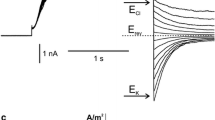Summary
The conductance,G, and the electromotive force,E, of theChara membrane were determined accurately by using the current-clamp technique. The measurements at the final steady state of inhibitor poisoning give the conductance,g 1, and the electromotive force,E 1, of the passive ion conducting pathways. By knowing these values the conductance,g 2, and the electromotive force,E 2, of the electrogenic pump can be calculated from the measuredG andE at each time during the progress of inhibitor poisoning. The local closed circuit current,i, which usually causes a hyperpolarization across the passive conducting pathways, can be calculated by usingg 1,g 2,E 1 andE 2 thus determined. The values ofg 2 andi decrease monotonically to zero with the progress of poisoning, whileE 2 approachesE 1 asymptotically after a transient hyperpolarization. During excitationi increases markedly. Such an increased inward current through the passive conducting pathways may help in accelerating the inactivation of the excitatory mechanism.
Similar content being viewed by others
References
Cole, K.S. 1968. Membranes, Ions and Impulses. II and III. University California Press. Berkeley-Los Angeles
Cole, K.S., Kishimoto, U. 1962. Platinized silver chloride electrode.Science 136:381
Cole, K.S., Moore, J.W. 1960. Ionic current measurements in the squid giant axon membrane.J. Gen. Physiol. 44:123
Gould, J.M. 1976. Inhibition by triphenyltin chloride of a tightly bound membrane component involved in photophosphorylation.J. Biochem. 62:567
Gradmann, D. 1975. Analog circuit of theAcetabularia membrane.J. Membrane Biol. 25:183
Gradmann, D., Hansen, U.-P., Long, W.S., Slayman, C.L., Warncke, J. 1978. Current-voltage relationships for the plasma membrane and its principal electrogenic pump inNeurospora crassa: I. Steady-state conditions.J. Membrane Biol. 39:333
Hopfer, U., Lehninger, A.L., Thompson, T.E. 1968. Protonic conductance across lipid bilayer membranes induced by uncoupling agents for oxidative phosphorylation.Proc. Nat. Acad. Sci. USA 59:484
Keifer, D.W., Spanswick, R.W. 1978. Activity of the electrogenic pump inChara corallina as inferred from measurements of the membrane potential, conductance and potassium permeability.Plant Physiol. 62:653
Keifer, D.W., Spanswick, R.M. 1979. Correlation of adenosine triphosphate levels inChara corallina with the activity of the electrogenic pump.Plant Physiol. 64:165
Kitasato, H. 1968. The influence of H+ on the membrane potential and ion fluxes ofNitella.J. Gen. Physiol. 52:60
MacRobbie, E.A.C. 1970. The active transport of ions in plant cells.Q. Rev. Biophys. 3:251
Rapoport, S.I. 1970. The sodium-potassium exchange pump: Relation of metabolism to electrical properties of the cell. I. Theory.Biophys. J. 10:246
Richard, J.L., Hope, A.B. 1974. The role of protons in determining membrane electrical characteristics inChara corallina.J. Membrane Biol. 16:121
Saito, K., Senda, M. 1974. The electrogenic ion pump revealed by the external pH effect on the membrane potential ofNitella. Influences of external ions and electrical current on the pH effect.Plant Cell Physiol. 15:1007
Shimmen, T., Tazawa, M. 1977. Control of membrane potential and excitability ofChara cells with ATP and Mg2+.J. Membrane Biol. 37:167
Slayman, C.L. 1965a. Electrical properties ofNeurospora crassa: Effects of external cations on the intracellular potential.J. Gen. Physiol. 49:69
Slayman, C.L. 1965b. Electrical properties ofNeurospora crassa: Respiration and the intracellular potential.J. Gen. Physiol. 49:93
Slayman, C.L., Long, W.S., Lu, C.Y.-H. 1973. The relationship between ATP and an electrogenic pump in the plasma membrane ofNeurospora crassa.J. Membrane Biol. 14:305
Spanswick, R.M. 1972. Evidence for an electrogenic ion pump inNitella translucens. I. The effects of pH, K+, Na+, light and temperature on the membrane potential and resistance.Biochim. Biophys. Acta 288:73
Stockdale, M., Dawson, A.P., Selwyn, M.J. 1970. Effects of trialkyltin and triphenyltin compounds on mitochondrial respiration.Eur. J. Biochem. 15:342
Ussing, H.H., Zerahn, K. 1951. Active transport of sodium as the source of electrical current in the short-circuited isolated frog skin.Acta Physiol. Scand. 23:110
Author information
Authors and Affiliations
Rights and permissions
About this article
Cite this article
Kishimoto, U., Kami-ike, N. & Takeuchi, Y. The role of electrogenic pump inChara corallina . J. Membrain Biol. 55, 149–156 (1980). https://doi.org/10.1007/BF01871157
Issue Date:
DOI: https://doi.org/10.1007/BF01871157




